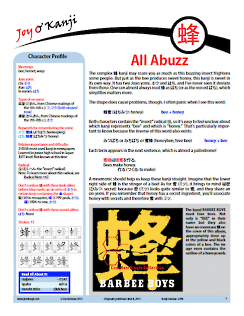蜂
bee; hornet; wasp
Kanji 2109
Thank you for visiting this Character Home Page. Below you'll find a synopsis of the essay. If you wish to read the full text, the PDF of the essay is available for purchase to the right.
Find out why some Japanese eat bee larvae and "royal jelly," what traditional Japanese beekeeping involves, how Japanese and Western honeybees differ, and where bees thrive in Japan. Learn to count bees and to say that they're buzzing or that a swarm has attacked! Read about "buzzing" in the ears and bee uprisings, and see why a figurative queen bee seems sexy and marketable in Japan.
Revision history:
Mar. 21, 2025: pp. 16 and 18: Changed 姫 in four breakdowns from "princess" to "small" and altered the surrounding commentary accordingly.
Dec. 13, 2024:
- p. 1: Expanded the mnemonics discussion and reorganized the text, also excluding みちばち as a yomi of 蜜蜂.
- p. 2: Clarified the explanation of Tsushima.
- p. 8: Revised the discussion of ways in which people drink honey; it's not in green tea, only black. Also made the last sample sentence more natural in both languages.
- p. 8 sidebar: Improved the wording of the first paragraph.
- p. 10, 1st sidebar: Added a cross-reference to essay 2116 for more information on the topic.
- p. 10, 2nd sidebar: Corrected the statement about the current use of one kind of incense; it likely does not contain honey but rather smells like honey.
June 3, 2021:
- p. 2: Added the Henshall etymology.
- p. 5 sidebar: Slightly modified my comment about the surname 蜂巣.
- p. 9: Slightly modified the discussion of 蜂屋柿 (hachiya persimmon).
- p. 17: In the quiz answer, I changed Spizaetus nipalensis to Nisaetus nipalensis.
- p. 18: Added a link to the Kanshudo games.
May 8, 2015: Originally published.



Comments